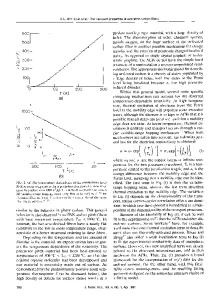Application of the intra-particle diffusion model for activated carbon fibers in an aqueous medium
- PDF / 218,667 Bytes
- 6 Pages / 432 x 648 pts Page_size
- 100 Downloads / 351 Views
Application of the intra-particle diffusion model for activated carbon fibers in an aqueous medium Teresa Ramírez-Rodríguez1 and Fray de Landa Castillo-Alvarado1 1 Escuela Superior de Física y Matemáticas, Instituto Politécnico Nacional, 07738 Ave. IPN, D.F, México. ABSTRACT The intra-particle diffusion model (IPD), proposed by Weber and Morris has been applied to the analysis of the kinetics of adsorption on activated carbon fibers with phosphate groups in the removal of cadmium ions in aqueous media. It is evident that the removal of cadmium ion kinetic model of pseudo-second order provides a better fit than the model of pseudo-first order and the intra-particle diffusion model provides the best to the sample compared activating solution: grams fibers of 1:3. INTRODUCTION The removal of heavy pollutants is wastewater treatment has been studied by several researchers [1-3]. Some of the pollutants released in the wastewater are in relatively high concentrations, Ni, Zn, Cd, Pb and Cr. In this paper it has been consider the model intra-particle diffusion and adsorption kinetics to describe the uptake of cadmium ions in a porous adsorbent immersed in an aqueous solution. This process is considered to be controlled by the diffusion of soluble species through the pores in activated carbon fibers (ACF) and the simultaneous adsorption of the active sites within the walls of the pores. THEORY In the kinetic models have the hypothesis that the adsorption rate is controlled solely by the rate of the solute in the adsorbent surface and intra-particle diffusion and external mass transport cannot be considered. The adsorption kinetic is commonly modeled with the equations of pseudo-first and pseudo-second order. Kinetic model of pseudo-first order The adsorption rate equation of pseudo-first order was originally designed by Lagergren in 1898 for systems liquid-solid [4].
dqt = k ( qe − qt ) dt
(1)
149
Where qe y qt (mg g-1) are the adsorption capacities at equilibrium and at a time t, respectively (mg g-1) and k, is the adsorption constant of pseudo-first order (min-1). Integrating the equation (1) with boundary conditions: t = 0, q0 = 0, t = t1, qt = q1 It has obtained the integrated rate law for an adsorption reaction pseudo-first order, which becomes in its linear form: k log ( qe − qt ) = log ( qe ) − t (2) 2.303 Kinetic model of pseudo-second order
In 1995 Ho presented the adsorption rate expression for pseudo-second order, which shows how the rate of adsorption depends on the adsorption capacity at equilibrium and the concentration of the adsorbate [5]. In an attempt to represent the equation of adsorption of divalent metals in a material during agitation was assumed that the process can be of second order and considering the chemical adsorption involving divalent metal covalent forces; second-order reaction may depend on the amount of divalent metal ions on the surface of the material and the amount of divalent metal ions adsorbed at equilibrium. The rate expression for adsorption is described:
dqt 2 = k ( qe − qt
Data Loading...











